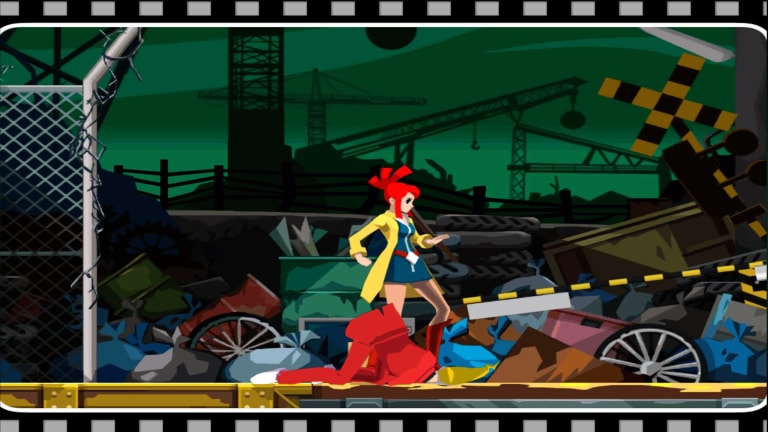
Ghost Trick Phantom Detective review: Paranormal puzzle excellence

Getting shot in a junkyard is a pretty bad way to die, but it’s arguably worse if you wake up as an amnesiac ghost afterward and have to save the world. Such is the fate of Sissel in Capcom’s Ghost Trick: Phantom Detective, a remastered version of the 2010 Nintendo DS puzzle adventure from Ace Attorney creator Shu Takumi. Sissel is a secret agent involved in some shady business that wound up getting the better of him. His time might be up, but he can, at least, keep others from sharing the same sad fate – if you’re clever enough to figure out how.
Ghost Trick’s opening is a bit slow and simple, an impression not helped by excessive repetition in Sissel’s conversations with his guide, a talking desk lamp. It gets much more interesting after you finally leave the junkyard and gradually piece together a broader picture of what’s happening in the city and who’s involved in it.
Ghost Trick’s supporting cast is a charming and bizarre bunch who would intimidate even a seasoned psychologist – exactly what you’d expect from a Shu Takumi game, in other words. There’s a besotted surveillance officer, a scientist with a pigeon living on his head, and a novelist so confident in her abilities that she types with one hand while holding a drink in the other – when she’s not trying to crush the neighbor’s dog under a wall. My favorite has to be the chief inspector, a Johnny Bravo type who dances up and down stairs and pauses to strike at least three stylish poses before starting a conversation.
Ghost Trick’s English script is the same as the 2010 original, but aside from a handful of typos that remained intact and a few sleazy characters with an unhealthy interest in Lynne, it didn’t really need to change. The localization is crammed with personality and little flourishes that often tell more of a character’s story than the actual words do.
Those stories end up in some surprising places as well. Pretty much everyone Sissel meets ends up playing a role in the dark deeds unfolding across the city, and it’s impressive how memorable they feel, even if their big role is just speaking a few words and picking up a telephone for Sissel to travel through or dropping some headphones in a fish tank.
Once the talking is done, it’s time for Sissel to take action. He gained special powers after dying and can perform a ghost trick – wink wink – which lets him inhabit inanimate objects and manipulate them in certain ways. He can also travel back four minutes before a person’s death and try to change their fate.
Ghost Trick’s puzzles are linear – there’s only one correct solution and one way to arrive at it – but you still feel pretty darn clever after figuring it out. One chain of events requires you to lure a rat out of an attic, knock him onto a bookshelf with a drinky bird, use a windmill to swoosh him onto the floor next to a dictionary, where he squeaks and attracts the attention of the woman trying to find said dictionary, which is also where Sissel’s soul is hiding.
These challenges are tactile in the most satisfying way and cleverly weave physics and location into their solutions. They also rely rather heavily on close timing and pinpoint accuracy, without adding any accessibility features to help people deal with these requirements, which is a bit disappointing.
Ghost Trick maintains excellent pacing throughout the twisty story. You spend Sissel’s time exploring key locations in the city and gathering information before stumbling on something big and advancing the story. These significant moments typically involve saving someone, human or otherwise, from a tragic death, and unlike your leisurely jaunts through other people’s houses, you only have four minutes to change their fate – sometimes less.
Capcom keeps the structure fresh by throwing in little changes from time to time. One puzzle gives you 10 seconds instead of four minutes, for example, or you might unlock multiple new areas at once, all with some measure of relevance to the current situation.
Like most games of its type, though, Ghost Trick occasionally falls into the trap of its own cleverness. Some puzzles have a seemingly obvious path that technically should work, but because it’s not Ghost Trick’s solution, you waste several minutes experimenting with it before finally realizing.
That would just be a minor annoyance if you could rewind time as you see fit, but Sissel can only go back to certain checkpoints during a mission. Even a simple mistake often means having to sit and wait a while for the stage to set itself the right way again.
You eventually learn to think like Ghost Trick expects you to, though, thanks in part to Capcom’s own trick: a smart hint system. Ghost Trick gives you just enough gentle guidance that you have a general idea of what a solution is, but still have to untangle how it works, and you even learn a bit about the intended solution when you fail. These short segments are entirely skippable too, so you’re free to push through unassisted if you want.
Ghost Trick’s surprisingly enticing story gradually pulls you in, and its unique approach to puzzle solving remains fresh throughout the roughly 10-hour run time. The script is brilliant, and the updated visuals and soundtrack are equally impressive. Even after 13 years and with minimal changes, Ghost Trick: Phantom Detective is one of the smartest, most enjoyable narrative puzzlers around.
Score: 9/10
- Story: 9
- Visuals: 8
- Mechanics and systems: 9
- Music and audio: 10
Ghost Trick Technical Breakdown
Capcom opted to shrink Ghost Trick’s screen size a bit and put it in a bordered window, with your time limit and a few logos on either side. It’s a rather inelegant solution to the problem of Ghost Trick first existing on Nintendo’s dual-screen handheld, though the change from managing Sissel’s actions with the stylus to using a control stick and buttons feels much more natural.
Capcom gave Ghost Trick’s DS visuals a slick overhaul, smoothing out the grainy models and giving it a pleasant comic-book style.
Version tested: PS4








